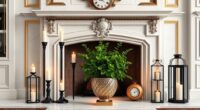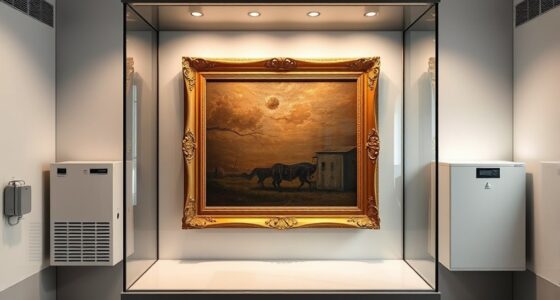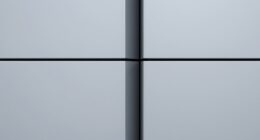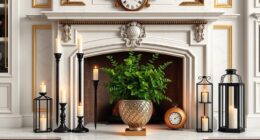If you’re choosing between beadboard and shiplap for wall use, consider their styles and spaces. Beadboard is ideal for traditional or cozy areas like bathrooms or dining rooms, thanks to its detailed, symmetrical pattern. Shiplap offers a sleek, modern look perfect for accent walls in living rooms or outdoor spaces like porches. Understanding these differences helps you pick the best option for your style and project—exploring more reveals which suits your home best.
Key Takeaways
- Beadboard is ideal for traditional, detailed wall paneling in bathrooms, kitchens, and wainscoting areas.
- Shiplap creates bold, modern accent walls suitable for living rooms, bedrooms, and outdoor spaces.
- Beadboard’s symmetrical pattern suits interior applications needing a soft, classic aesthetic.
- Shiplap’s horizontal design enhances rustic or farmhouse-themed interior and exterior walls.
- Both styles can be used for feature walls but differ in visual impact and installation approach.

When choosing wall paneling for your space, beadboard and shiplap are two popular options that can dramatically change the look and feel of a room. Understanding their differences in paneling styles and installation techniques helps you decide which suits your project best. Beadboard features narrow vertical planks with distinctive beads or grooves between them, giving a classic, cottage-inspired charm. Shiplap, on the other hand, consists of wider boards with a slight gap or rabbet joint that creates clean, horizontal lines. Both styles add texture and dimension but evoke different moods—beadboard feels cozy and traditional, while shiplap leans toward modern rustic or farmhouse aesthetics.
When it comes to paneling styles, beadboard’s uniform, symmetrical pattern lends itself well to areas where a sense of tradition or softness is desired. It’s often used in spaces like bathrooms, kitchens, or wainscoting in dining rooms. Shiplap’s distinctive horizontal lines make it ideal for accent walls, creating a bold statement in living rooms or bedrooms. It’s also popular outdoors, in barns or porches, thanks to its weather-resistant qualities. The choice between these styles depends on your visual goals—whether you want a more intricate, detailed look with beadboard or a sleek, linear appearance with shiplap.
Installation techniques also vary considerably between the two. Beadboard typically involves attaching narrow planks vertically to the wall framing, often with nails or adhesive, then filling the beads for a seamless finish. It requires precise measuring and cutting to ensure the beads align perfectly. Shiplap’s wider boards are generally easier and faster to install because of their overlapping rabbet joints, which allow for a more straightforward installation process. Because of their rabbet joints, shiplap boards naturally overlap, creating a tight, weatherproof seal that’s easier to install with fewer seams to worry about. Both methods require careful surface preparation and precise alignment, but shiplap’s wider boards make it somewhat quicker to install, especially for larger areas.
Ultimately, your choice hinges on the look you want to achieve and how comfortable you are with installation. Beadboard offers a more detailed, traditional look but demands meticulous work during installation. Shiplap provides a clean, modern aesthetic that’s easier to put up, making it an excellent choice if you want quick results with a bold impact. Knowing your preferred paneling styles and mastering the right installation techniques will ensure your project turns out exactly as you envision. It’s also helpful to consider the authenticity of materials when aiming for a true farmhouse style.
Frequently Asked Questions
Which Wall Type Is More Moisture-Resistant for Bathrooms?
Shiplap is more moisture-resistant for bathrooms because its tight, overlapping design helps prevent water penetration, enhancing bathroom durability. Beadboard, with its grooves and seams, can trap moisture, making it less ideal in high-humidity areas. If you’re aiming for better moisture resistance, choose shiplap, and consider using water-resistant paints or sealants to increase overall bathroom durability and protect your walls from moisture damage.
Can Beadboard or Shiplap Be Painted Multiple Times Easily?
Surprisingly, you can paint beadboard or shiplap multiple times without much fuss, thanks to their sturdy surfaces. You might think paint durability is a concern, but with proper prep and quality paint, both offer excellent finish options that resist chipping and peeling. So go ahead, change your mind often—you’ll find re-painting these wall types easier than you’d expect, making updates quick and simple.
Are There Specific Cleaning Methods for Each Wall Type?
You should use gentle cleaning techniques for both beadboard and shiplap to avoid damage. For regular maintenance, dust the surfaces with a soft cloth or vacuum with a brush attachment. For more thorough cleaning, use a damp cloth with mild soap and water, then dry immediately. Avoid harsh chemicals or abrasive scrubbers. Proper maintenance tips help keep the wood looking fresh and prevent warping or paint damage over time.
Which Material Is More Affordable for Large-Scale Projects?
Shiplap tends to be more affordable for large-scale projects because of its cost comparison and simpler installation process. Beadboard, while offering a classic look, usually costs more due to intricate detailing and higher material durability. If you’re on a budget and need quick, large coverage, shiplap is your best choice. However, if durability and traditional aesthetics matter most, investing in beadboard might be worth the extra expense.
How Do Installation Times Compare Between Beadboard and Shiplap?
You’ll find shiplap generally installs faster than beadboard due to its tongue-and-groove design, which simplifies alignment and reduces installation time. If you’re a DIY enthusiast, shiplap’s straightforward process makes it more friendly for quick projects. Beadboard, with its more intricate pattern, takes longer to install and may require more precision. Overall, shiplap offers quicker installation speed and better DIY friendliness, saving you time and effort on your wall project.
Conclusion
Now that you’ve seen how beadboard and shiplap each bring their own charm, think of them as two stars in your decorating sky. Whether you want the cozy ripple of beadboard or the bold, clean lines of shiplap, you hold the brush to create a masterpiece. Your walls are blank canvases waiting for your personal touch—so pick your star and let your space shine brighter than ever. Your perfect wall awaits its moment in the spotlight!









